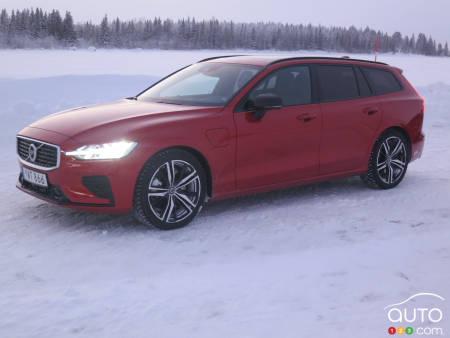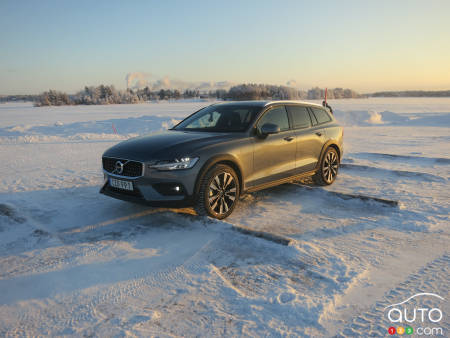Lulea, Sweden - Volvo is one of the best-known foreign car manufacturers in Canada, with a long presence that has seen it win the hearts and minds of many consumers here. While the company’s PV 544 of the late 50s, similar in shape to a 1940 Ford, was actually the first Volvo to hit our shores, it was the 122 family of models that built the company’s reputation.
Originally known overseas as the Amazon and rebadged the Canadian here (and assembled in Halifax), the 122 model was very popular in the 1960s, at least until the 240 model came along. At that point the car adopted a fairly square design. Throughout this period, motorists in Canada, and particularly in Quebec, fell in love with the station wagon version of the car.
While Volvos of that era certainly delivered strong performances, what convinced many buyers to trust the Swedish brand was their excellent reputation in the domain of safety. But there were other forces gathering steam on the marketplace: motorists started turning away from wagons and towards first minivans and then bigger and bolder SUVs.
Meanwhile, Volvo was going more and more upscale, though things weren’t looking too promising for the Swedish manufacturer, despite it joining the SUV fray. In the midst of dramatically dropping sales, Volvo’s car division was sold to American giant Ford. After benefiting from some technologies and innovations from Volvo, The U.S. giant, suffering through problems of its own, was forced in turn to sell off the Swedish brand.
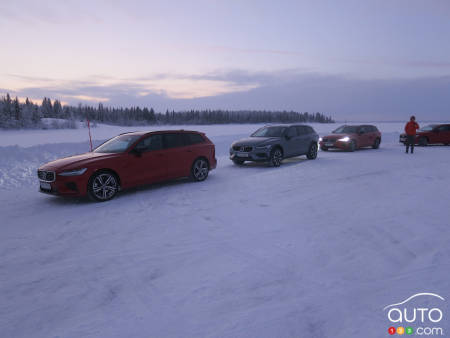
Geely enters the picture
This is where Chinese giant Geely Motors came into the picture, buying Volvo and even starting to build the brand’s models in China!
Fortunately, Volvo held onto its Swedish character as an automotive company, while beginning the process of redesigning its vehicles with a more modern flavour; one ingredient was an all-new supercharged and turbocharged 4-cylinder engine that would find its way into all of the brand’s models. All the while, Volvo kept designing and building station wagons.
Today, even with station wagons increasingly becoming an endangered species, some consumers still prefer the configuration that provides great cargo hauling capability without imposing an inconveniently high road clearance. After all, not everybody needs a big wagon to go off-roading… or an off-road vehicle to carry much material.
The now-defunct V70 was the perfect answer for those who also wanted a wagon that was resolutely NOT a truck and delivered European-type handling (and looks). Understandably, Volvo wanted to look forward and give its most popular station wagon a more modern touch. Meet the new V60.
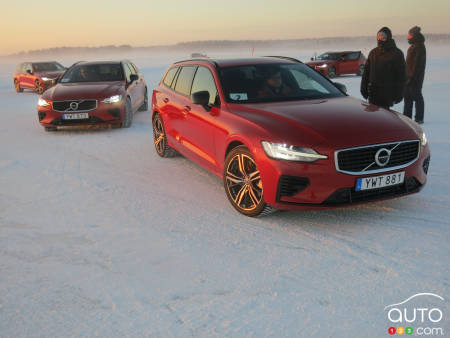
The all-new V60 was revealed in 2018, with the first models hitting the market in early 2019. Sitting on a slightly longer wheelbase platform than the V70 (actually, the most recent Scalable Product Architecture), it also shows its very modern (and low) lines that distinguishes it from the XC60 SUV.
The new S60 was launched initially as a front-wheel driven T5 or all-wheel-drive T6 model. At the same time the automaker promised a Cross Country version and a more technologically advanced PHEV hybrid T8 “Twin-engine” coming soon. And that is what it is now presenting; the Cross Country is slated to be available in late January, and the T8 is scheduled for late summer.
Direction Sweden's far north
And what better place to introduce them than Lulea in Sweden…more precisely, way up in Northern Sweden, inside the Arctic Circle, where the temperature falls well below 20 degrees Celsius and where snow accumulates on the ground and on the roads like it does in many parts of Canada. And snow we had, in spades. Our reward for the long journey to Lulea was a first encounter with the first 2019 V60 T8 Twin Engine and Cross Country on a (very) frozen part of the Baltic Sea on the dying days of January!
The car looks as beautiful as it did in auto shows when it was unveiled. Its sleek design really reminds us of the gorgeous (but special order-only) V90 wagon. And it also looks bigger that it used to be. Yet, the same design also looks sportier and more European than ever.
The interior is as classy as ever with leather-covered seats and impeccable fit and finish all around. Before we get into the dashboard, we should point out that Volvo has succeeded in making some of the most comfortable seats in the industry; almost as large as many American sedan seats, they’re simultaneously softer than some of the harder seats to be found in German products.
The interior is vast and the low roof that makes the V60’s design doesn’t feel that low to the passengers. Rear passengers get a ton of space, and in the back there’s some 529 litres of cargo capacity left over for luggage and other stuff. And if you need more, the station-wagon configuration allows for boosting that volume up to 898 litres by folding the rear seats back. Access, of course, is made super easy via a large rear hatch.
The dashboard might look as classic as ever but its design makes it very user-friendly. The instrument panel is properly centered in front of the driver, but the flat front cover is mostly occupied by an imposing screen that looks more like a tablet than a typical car screen.
Adopting the new Sensus Connect approach, the computer doesn’t just look like a tablet, it functions like one. That means the driver swipes to access the navigation and heating systems, the radio and the whole Sensus Connect infotainment program that’s compatible with Apple Carplay, Android Auto and 4G. There’s a small learning curve at the beginning but a little practice makes it all good.
The console between the (heated and ventilated) front seats incorporates the gear shifter, the only starter switch (turn to start, turn to stop) and a little wheel that allows for choosing between normal, performance, sport or off-road handling and suspension options.
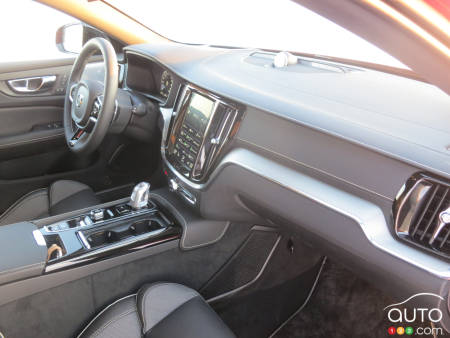
The CC
The Cross Country version is easily recognizable with its higher stance (75 mm higher than the regular V60), its bigger wheels and its side claddings. The engine under the hood is Volvo’s 2.0L DOHC supercharged and turbocharged 4-cylinder engine delivering some 258 hp and 250 lb-ft of torque (at heart the Cross Country is pretty much a T5 AWD). It comes mated to an 8-speed automatic transmission and, obviously, all-wheel drive.
The standard tires are 235/50 R18 as the optional ones are 235/45 R19 variants (for our first contact in Sweden the Cross Country was equipped with studded Michelin winter tires).
The T8
The more-elaborate Hybrid T8 looks very much like the standard V60 until you notice the little door on the left front fender. That’s where to plug in the vehicle, because this Volvo is a PHEV. Its range will vary according to the outside temperature but we expect it will drive something close to or better than 40 km on battery power before the engine kicks in. In addition, the two rear electric motors make this wagon an all-wheel drive-vehicle, with a total output of around 400 hp.
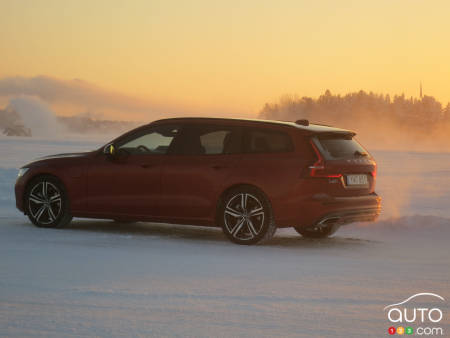
First contact in Sweden
Volvo thought it would be a good idea to have a first contact with its two new wagons in its home country. So we flew all the way north to a beautiful (but very cold in winter) city called Lulea on a bay that opens onto the Baltic Sea. We started our drive with the T8 R-Design on some of the area’s hard-packed snow country roads and ice roads, going until late in the afternoon, long after the sun had set around 3:00 pm.
The T8 is so transparent that we never felt when it went from electric to electrically assisted. Yet we could really appreciate the same positive driving sensation felt in almost all the Volvos we’ve driven in the past (remember that all Volvos now sit on a similar platform, delivering a similar experience).
By the way, all the T8 cars that were available to drive were shod with Nokian Hakkapeliitta studded tires that are a must in that area. Unless you push the car past its limits, Volvo’s safety systems will help you stay on the road.
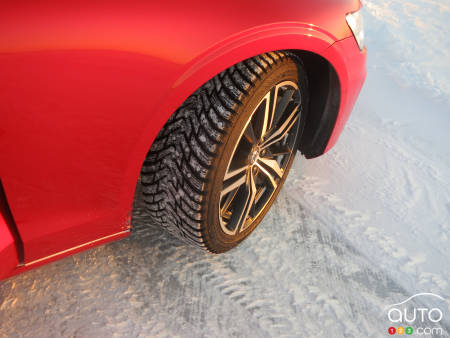
Visibility is great all around and interior amenities are on a par with what you’d expect from any other European car of that calibre. Even the headlamps surprised us with their lighting power (though local residents do rely upon additional driving lamps on the country roads).
Accelerations felt quite adequate (though to be fair, it’s very difficult to measure 0-100 km/h times on ice and snow!) and passing power even more so.
As far as fuel economy is concerned, we predict this wagon will deliver an average of 8L to 9L/100 km since the car is technically similar to the XC60 T8 version. This all-new hybrid wagon should be available next fall and pricing will be known then.
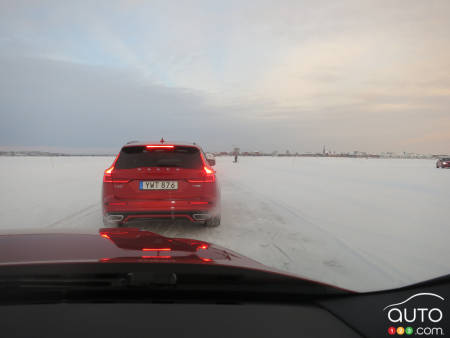
On a frozen sea!
Volvo had also scheduled some dynamic testing on an ice race course on the frozen Baltic Sea (yes that part of the sea freezes, especially at minus 25 degrees C and it produces a solid base of more than 80 cm!). The course was designed to prove the different capabilities of Volvo’s many driving aids from the normal mode to the all-out performance mode without any driving aid.
Hopping aboard the Cross Country will require climbing over a higher sill (beware, the larger and higher sill might dirty your pant legs!) but the environment will be very similar to most Volvo products. In other words, whatever applies to the V60, ditto for the Cross Country. The most significant difference is that the shift gate on the T8 includes the Park switch on the console while the one on the Cross Country has its Park position at the top of the gate as found in most cars.
Volvo also gave us the chance to drive the Cross Country on its ice courses. For our money, however, a more interesting part of the test was on a short but demanding off-road course where drivers had to negotiate steep curves and demanding obstacles they were required to climb or drive over. No surprise, each obstacle was dealt with easily.
As mentioned, the extreme cold (-24 degrees Celsius under sunny skies) and the short runs meant we couldn’t really measure fuel consumption, but we expect it to run close to the 9.4L/100 km advertised by the manufacturer for its regular V60 AWD.
This Volvo CC wagon should be on sale by the start of February 2019. The published price starts at $48,900, but expect it to be more when all the options are factored in.
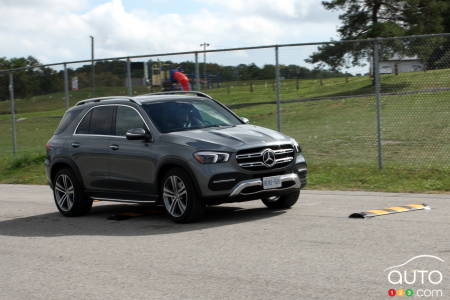
Volvo sales have been growing healthily in Canada in recent months. As far as station wagons are concerned, Volvo Canada’s national sales director, Hugues Bissonnette, believes that more than 50% of the wagons sent to Canada will land in Quebec where this type of vehicle is still more popular.
The Volvo V60 will be built in Sweden and Belgium while the S60 sedan will be assembled at the company’s new plant in South Carolina. Expect a full report on each car from Auto 123.com as soon as they reach our shores.
